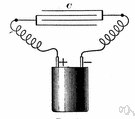impedance
Also found in: Thesaurus, Medical, Legal, Financial, Acronyms, Encyclopedia, Wikipedia.
im·ped·ance
(ĭm-pēd′ns)n.
1. Symbol Z A measure of the total opposition to current flow in an alternating current circuit, made up of two components, ohmic resistance and reactance, and usually represented in complex notation as Z = R + iX, where R is the ohmic resistance and X is the reactance.
2. An analogous measure of resistance to an alternating effect, as the resistance to vibration of the medium in sound transmission.
American Heritage® Dictionary of the English Language, Fifth Edition. Copyright © 2016 by Houghton Mifflin Harcourt Publishing Company. Published by Houghton Mifflin Harcourt Publishing Company. All rights reserved.
impedance
(ɪmˈpiːdəns)n
1. (Electronics) a measure of the opposition to the flow of an alternating current equal to the square root of the sum of the squares of the resistance and the reactance, expressed in ohms. Symbol: Z
2. (Electronics) a component that offers impedance
3. (General Physics) Also called: acoustic impedance the ratio of the sound pressure in a medium to the rate of alternating flow of the medium through a specified surface due to the sound wave. Symbol: Za
4. (General Physics) Also called: mechanical impedance the ratio of the mechanical force, acting in the direction of motion, to the velocity of the resulting vibration. Symbol: Zm
Collins English Dictionary – Complete and Unabridged, 12th Edition 2014 © HarperCollins Publishers 1991, 1994, 1998, 2000, 2003, 2006, 2007, 2009, 2011, 2014
im•ped•ance
(ɪmˈpid ns)n.
1. the total opposition to alternating current by an electric circuit, equal to the square root of the sum of the squares of the resistance and reactance of the circuit and usu. expressed in ohms.
2. the ratio of the force on a system undergoing harmonic motion to the velocity of the particles in the system.
[1886]
Random House Kernerman Webster's College Dictionary, © 2010 K Dictionaries Ltd. Copyright 2005, 1997, 1991 by Random House, Inc. All rights reserved.
im·ped·ance
(ĭm-pēd′ns) A measure of the opposition to the flow of an electric current through a circuit of alternating current. Impedance is measured in ohms.
The American Heritage® Student Science Dictionary, Second Edition. Copyright © 2014 by Houghton Mifflin Harcourt Publishing Company. Published by Houghton Mifflin Harcourt Publishing Company. All rights reserved.
ThesaurusAntonymsRelated WordsSynonymsLegend:
Switch to new thesaurus
| Noun | 1. |  impedance - a material's opposition to the flow of electric current; measured in ohms impedance - a material's opposition to the flow of electric current; measured in ohmselectrical phenomenon - a physical phenomenon involving electricity ohmage - the ohmic resistance of a conductor |
Based on WordNet 3.0, Farlex clipart collection. © 2003-2012 Princeton University, Farlex Inc.
Translations
impedanssi
impedancija
impedancia
Collins Spanish Dictionary - Complete and Unabridged 8th Edition 2005 © William Collins Sons & Co. Ltd. 1971, 1988 © HarperCollins Publishers 1992, 1993, 1996, 1997, 2000, 2003, 2005